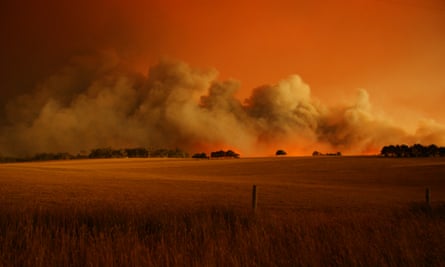Extract from The Guardian
Across most forest types and ages, thinning had little impact on the severity of Black Saturday fires in Victoria, ANU study suggests

Last modified on Thu 8 Oct 2020 03.31 AEDT
Removing trees to thin out forests is unlikely to cut the risk of severe bushfires despite the claims of forest industry groups, according to the authors of a new study.
Analysis of forests that burned in Victoria’s Black Saturday fires in 2009 found in most cases areas that had been thinned did not see less severe burning and, depending on the type of trees, such intervention sometimes made fires more intense.
Several forestry groups earlier this year told the royal commission into Australia’s unprecedented summer of bushfires that wide-scale thinning of forests in the future should be carried out to cut the risk of bushfires.
But the authors of the study, from the Australian National University, say their findings suggest there is little evidence to support such moves, and “in some cases, it may exacerbate fire risks”.
Appearing in the journal Conservation Letters, the study analysed two types of forest burned in the Black Saturday fires in Victoria’s central highlands – ones dominated by mountain and alpine ash, and others with a mix of eucalypts.
Thinning made burns more severe in forests with a mix of species that were 70 years or older, the findings suggest. Thinning only reduced the chance of crown burns – where all the leaves of a tree are burned – in younger mixed-species forests.
Dr Chris Taylor, the study’s lead author, said across most forest types and ages, thinning appeared to have little impact on the severity of fires.
Taylor told Guardian Australia that thinning tended to leave fuel on the forest floor and the machinery used could also crush vegetation.
“What you have left is an abundance of fuel that dries out and becomes a fire risk,” he said.
The study also says thinning can make a forest drier as well as increase air flow “potentially facilitating the spread of fire through the forest”.
Its co-author, Prof David Lindenmayer, said the study “basically says that the solution that the industry is suggesting to help solve the problem is not going to help”.
Lindenmayer said most thinning operations involved removing younger trees up to 40 years old that are then chipped for paper pulp.
Studies on the impacts of thinning on fire severity are conflicting. But Lindenmayer said studies that found support for thinning tended to be based on models. “The only place where thinning has had a positive effect [on fire severity] is in models,” he said.
In submissions to the royal commission earlier this year, at least three forest industry groups advocated for widespread thinning to cut the risk of bushfires.
The Australian Forest Products Association told the commission that thinning – where half of the trees in a forest were removed – could reduce fire risks.
An AFPA spokesperson declined to comment on the findings of the study but pointed to a report from the organisation advocating for mechanical fuel reduction to be used more widely.
Prof Rodney Keenan, of the University of Melbourne and a forestry scientist, has written publicly supporting the use of thinning to cut the risk of fire.
He told Guardian Australia he disagreed with the authors and said the study had covered only a relatively small area.
He said: “I wouldn’t be dismissing more widespread thinning as a fire management option on the basis of this study.”
Studies in Australia and the United States, he said, showed a combination of thinning and reduction of fuel on the ground gave the best protection against severe fire.
“The other important message from the study is that very little thinning has been done, so we can’t really judge the widespread effects.
“If we want to see if thinning works, we have to try it at scale, monitor the outcomes, and work out where it can be of most benefit.”
A spokesperson for the Victorian Association of Forest Industries said in a statement the group had not advocated for indiscriminate thinning at a landscape scale, but as part of a suite of land management options as part of a national bushfire strategy.
The statement said: “The submission outlined the numerous benefits, in terms of bushfire risk management and response, that arise from active and appropriate silvicultural approaches delivered by a secure forest and timber industry. Landscape-scale management should feature a range of approaches, considered in the context of the entire forest landscape and employed as locally appropriate.”
No comments:
Post a Comment